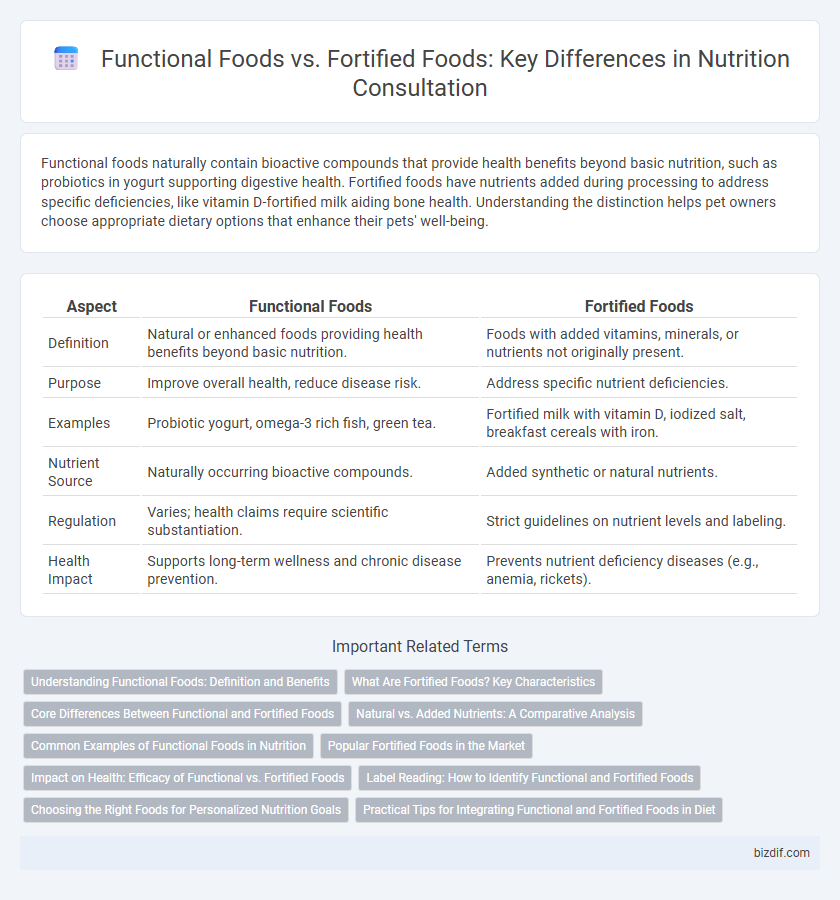Functional foods naturally contain bioactive compounds that provide health benefits beyond basic nutrition, such as probiotics in yogurt supporting digestive health. Fortified foods have nutrients added during processing to address specific deficiencies, like vitamin D-fortified milk aiding bone health. Understanding the distinction helps pet owners choose appropriate dietary options that enhance their pets' well-being.
Table of Comparison
| Aspect | Functional Foods | Fortified Foods |
|---|---|---|
| Definition | Natural or enhanced foods providing health benefits beyond basic nutrition. | Foods with added vitamins, minerals, or nutrients not originally present. |
| Purpose | Improve overall health, reduce disease risk. | Address specific nutrient deficiencies. |
| Examples | Probiotic yogurt, omega-3 rich fish, green tea. | Fortified milk with vitamin D, iodized salt, breakfast cereals with iron. |
| Nutrient Source | Naturally occurring bioactive compounds. | Added synthetic or natural nutrients. |
| Regulation | Varies; health claims require scientific substantiation. | Strict guidelines on nutrient levels and labeling. |
| Health Impact | Supports long-term wellness and chronic disease prevention. | Prevents nutrient deficiency diseases (e.g., anemia, rickets). |
Understanding Functional Foods: Definition and Benefits
Functional foods are natural or processed foods that provide health benefits beyond basic nutrition due to bioactive compounds such as phytochemicals, probiotics, and antioxidants. These foods help reduce the risk of chronic diseases, improve gut health, and enhance immune function by supporting physiological processes. Understanding functional foods enables personalized nutrition strategies that promote long-term wellness and disease prevention.
What Are Fortified Foods? Key Characteristics
Fortified foods are products enhanced with added vitamins, minerals, or other nutrients not originally present to improve their nutritional value. Key characteristics include targeted nutrient enrichment, regulatory approval ensuring safety and efficacy, and the goal to address specific nutrient deficiencies in the population. Examples include iodized salt, vitamin D-enriched milk, and iron-fortified cereals, all designed to support overall health and prevent malnutrition-related conditions.
Core Differences Between Functional and Fortified Foods
Functional foods naturally contain bioactive compounds that promote health beyond basic nutrition, such as probiotics in yogurt or antioxidants in berries. Fortified foods are products enhanced by adding essential vitamins or minerals that are not originally present or are present in insignificant amounts, like milk fortified with vitamin D or cereal enriched with iron. The core difference lies in their origin: functional foods deliver inherent health benefits through natural components, while fortified foods achieve improved nutritional value through purposeful supplementation.
Natural vs. Added Nutrients: A Comparative Analysis
Functional foods contain naturally occurring bioactive compounds that offer health benefits beyond basic nutrition, such as antioxidants in berries or omega-3 fatty acids in flaxseeds. Fortified foods have nutrients added during processing to replace or enhance nutritional value, like vitamin D in milk or iodine in salt. The distinction lies in functional foods' inherent nutrient profile versus fortified foods' supplementation, impacting dietary strategy and health outcomes.
Common Examples of Functional Foods in Nutrition
Functional foods include yogurt with probiotics, oatmeal rich in soluble fiber, and fatty fish high in omega-3 fatty acids, all known for promoting gut health, lowering cholesterol, and reducing inflammation. These foods naturally contain bioactive compounds that provide health benefits beyond basic nutrition. In contrast, fortified foods have nutrients added during processing, such as vitamin D in milk or iodine in salt, to address specific nutritional deficiencies.
Popular Fortified Foods in the Market
Popular fortified foods in the market include breakfast cereals enriched with iron, calcium-fortified orange juice, and milk fortified with vitamin D to support bone health. These products undergo nutrient enhancement during processing to address common dietary deficiencies and improve public health outcomes. Functional foods, in contrast, naturally contain bioactive compounds that provide health benefits beyond basic nutrition without additional fortification.
Impact on Health: Efficacy of Functional vs. Fortified Foods
Functional foods contain bioactive compounds that provide health benefits beyond basic nutrition, such as antioxidants, probiotics, and phytochemicals, which actively support disease prevention and overall wellness. Fortified foods are enhanced with essential vitamins and minerals to address specific nutrient deficiencies, improving population health by reducing risks of conditions like anemia or rickets. Evidence suggests functional foods may offer broader and more targeted health impacts, while fortified foods primarily ensure adequate nutrient intake.
Label Reading: How to Identify Functional and Fortified Foods
When reading labels to identify functional foods, look for terms like "probiotics," "prebiotics," or "antioxidants" that indicate naturally occurring, health-enhancing ingredients. Fortified foods typically display added nutrients such as "vitamin D," "calcium," or "iron" prominently on the nutrition facts panel or ingredients list. Understanding these label cues helps consumers make informed choices to support specific health goals through targeted nutrient intake.
Choosing the Right Foods for Personalized Nutrition Goals
Functional foods naturally contain bioactive compounds that provide health benefits beyond basic nutrition, such as omega-3 rich fish and probiotics in yogurt. Fortified foods have nutrients added to enhance their nutritional value, like vitamin D in milk or calcium in orange juice, targeting specific deficiencies or health concerns. Selecting between functional and fortified foods depends on individual health goals, dietary needs, and nutrient gaps, making personalized nutrition consultations essential for optimal diet planning.
Practical Tips for Integrating Functional and Fortified Foods in Diet
Incorporate functional foods like berries, nuts, and fermented products to boost antioxidants and probiotics naturally, enhancing digestive and immune health. Choose fortified foods such as calcium-enriched orange juice and vitamin D-fortified cereals to address specific nutrient gaps efficiently. Practical integration involves balancing whole functional foods with targeted fortified options to optimize nutrient intake without excessive supplementation.
Functional Foods vs Fortified Foods Infographic

 bizdif.com
bizdif.com